How To Fix Hp W2371b Purple/pink Tint
The HP DreamColor LP2480zx is a top-of-the-line color-critical monitor that retailed for $3500 and features some really impressive specs, such equally a truthful 10-bit IPS console, hardware-based scale, and an RGB LED backlight. Unfortunately, these monitors eventually develop a purple/magenta color cast over the entire screen and calibrating with HP'south proprietary solution does not gear up the problem. I got my easily on one of these monitors on eBay for effectually $100 (then around 3% of the retail price) due to the same purple-tint issue and set up out to set information technology. Here is my journey.
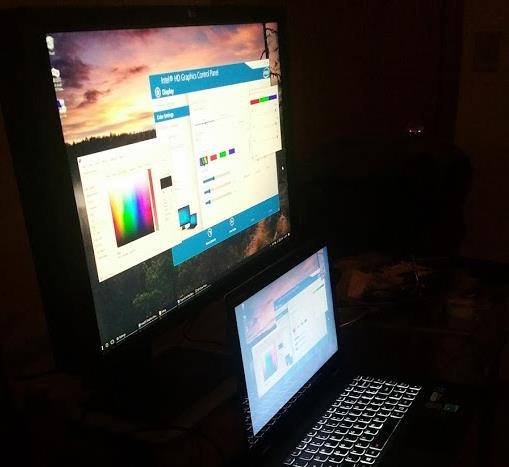
DreamColor vs laptop IPS
The tech
The first question on many people's minds is "why carp?" Aside from the enjoyment of solving problems and tinkering with electronics, this monitor boasts some seriously impressive specs even past today'southward standards, despite being released way back in 2008. The monitor was adult by HP in collaboration with DreamWorks Animation (hence the proper name) and was used for color-critical piece of work. Here are some of the goodies:
- True 10-bit IPS console which allows for not l, non 256, but a whopping 1024 shades of grey and a full of over one.07 billion colors. The modern-day DreamColor monitors are inferior since they apply 8-chip panels with dithering (AFRC).
- RGB LED backlight which allows for adjustments to the white residue of the display without whatever loss of colour resolution and compensation for article of clothing over time (at least in theory... more than on this below).
- Extremely wide color gamut which exceeds "broad gamut" Adobe RGB and nearly meets the Digital Movie theatre P3 gamut. This monitor will display colors that most monitors just can't.
- "DreamColor Engine" which performs hardware-based calibration of the monitor. This is accomplished via matrix multiplier which allows for some rather sophisticated color transformations. Color space presets can exist speedily selected via the press of a button and are meant to be programmed in via a proprietary calibration probe and software, ensuring authentic colors throughout the life of the monitor.
- A-TW polarizer which greatly reduces "IPS glow", where colors appear done out when viewed off-angle. Yous can clearly come across the difference between a monitor with and without information technology in the flick at the peak of this folio.
The problem
The monitor uses an LG LM240WU5-SLA1 panel with an RGB backlight. Since LEDs can age at different rates (which causes colors to drift over fourth dimension), LG thoughtfully included a color sensor and a color processing chip (Avago HDJD-J822) to maintain uniformity of colors. This allows the residue of the monitor's electronics to not worry about backlight migrate – in fact, the backlight module accepts absolute Yxy coordinates instead of RGB for colors, which HP's circuitry uses to set brightness and white balance.
Unfortunately, the sensor in these panels goes bad within a few years. The failed sensor measures excessive amounts of greenish and compensates by turning downwards the green LEDs. Since there is no way to set individual RGB values for the backlight using the panel'due south interface, HP'due south circuitry is unable to compensate for this. The best it can do is utilize the DreamColor engine to calibrate the LCD panel, but afterwards a certain point, in that location simply isn't plenty greenish light for it to meet the characteristics of the desired color infinite and scale fails. The majestic color is seen at all times, including the "Scanning inputs" message that displays as soon every bit the monitor is powered on.
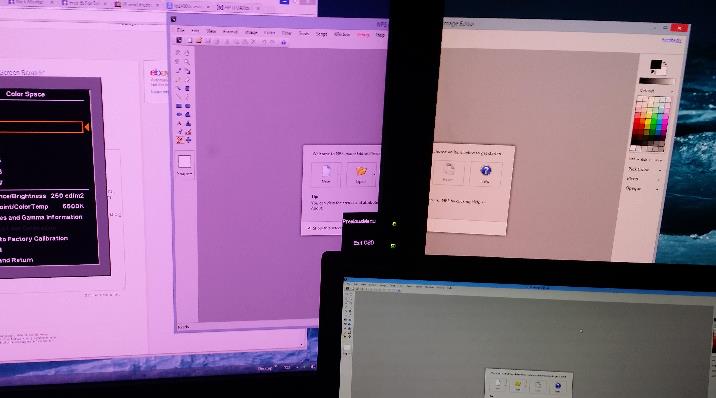
Magenta colour cast
The whole scenario reminds me of a Douglas Adams quote.
The major difference between a thing that might go wrong and a thing that cannot possibly go wrong is that when a thing that cannot possibly become incorrect goes wrong it ordinarily turns out to be impossible to get at or repair.
There is no style for monitors using this console to adjust private R/One thousand/B values of the backlight, whether via proprietary scale solution like the DreamColor or manual adjustment like well-nigh other monitors, considering the console merely does not provide the appropriate commands to exercise so. (Even LG'south ain W2420R has an RGB adjustment limited to requesting Yxy coordinates, which would be inaccurate due to the failed sensor.) The sensor that was intended to maintain the backlight'due south color uniformity over fourth dimension ended up making the problem far worse.
Exploring the color management system
I read through the datasheet of the Avago color chip and adamant that it used the sensor's inputs to drive PWM outputs to command the bodily backlight. The organization normally operates in a "closed loop" mode where requests for a particular color are modified based on what the sensor is reading. At the factory, the system is put into "open up loop" mode and an external colorimeter is used to measure actual values; this data is stored in the flake and is used for calculations during normal apply.
After disassembling the monitor, the first step was to unplug the sensor from the LED driver lath. I didn't take very high hopes simply I powered on the monitor. For the showtime time, I saw a pure white background in the "cheque video cable" bulletin, instead of a imperial-tinted ane. Success! Unfortunately this was short-lived, since any attempts at adjusting the monitor's settings (or even leaving it alone for a bit) resulted in each backlight colour fading to a single channel within a few minutes. Only a complete power-down of the monitor would bring back the brief white backlight.
One possible solution would be to alter the manufacturing plant scale data on the chip. Unfortunately this would be a short-term solution since the color sensor would keep to wearable out (and this wouldn't piece of work if the sensor anile as well far). I also lack the equipment and skills to remove and reinstall a surface-mounted chip in order to ship it the necessary I2C commands, and the datasheet isn't articulate on how to format the data.
Another possible solution would be to employ a variable resistor to recoup for the sensor's output. I did not accept success with this (splicing the resistor into the greenish aqueduct). Due to the organization operating in a closed loop, having the resistor even slightly off would upshot in similarly invalid results.
I eventually took the whole panel apart and removed the sensor itself. It was labeled "SD-9 94V-D" on ane side and "0831" on the other. Unfortunately I could non notice any data online most it, so replacing the sensor itself was out of the question. (And even if I could, information technology would likely have required manufactory scale.)
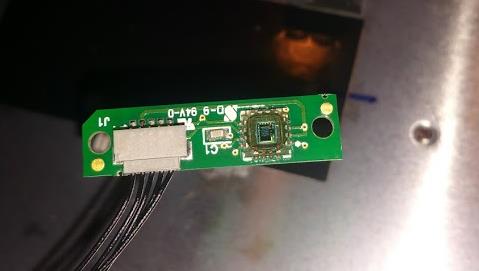
Color sensor
Directly controlling the backlight with an Arduino
At this point I realized that the only feasible selection was to directly control the backlight via PWM, bypassing the Avago color chip entirely. I had an Arduino at my disposal (which allows for several channels of PWM). Lacking whatsoever real tools for surface-mountain piece of work, I used an Xacto knife and needle-nose pliers to break the PWM output pins off of the chip, and so (afterwards much trial and error) managed to solder three wires to the pads underneath it. This was the point of no return.
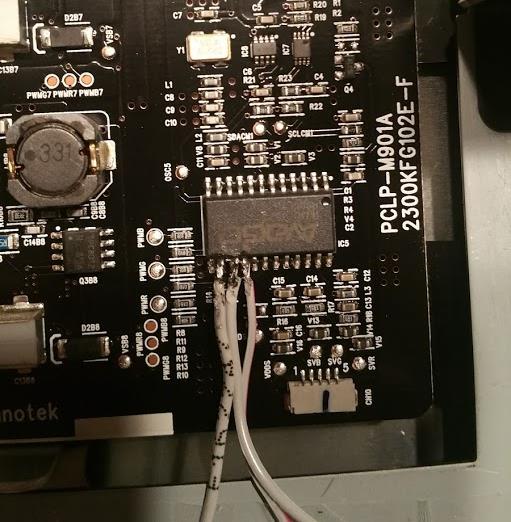
My poor solder chore on the Avago chip
I wrote up a quick sketch to cycle an RGB LED through the full colour spectrum and uploaded it to my Arduino. Then I plugged the Arduino into the monitor's USB hub, attached the wires, and turned it on. I was non expecting much, just to my surprise, the monitor powered up successfully and the "Check signal cable" bulletin displayed with a fading rainbow of colors!
The same affair from another angle:
Backlight control software
In social club to command the backlight, I created a simple Arduino sketch to hold the 3 PWM pins at a specific value, then listen over series for new values. I also created a forepart finish application to allow easy control from Windows. To keep things simple, I hard-coded default values (which are applied every time the monitor is powered on) but I could improve the functionality past allowing the Arduino to relieve those settings.
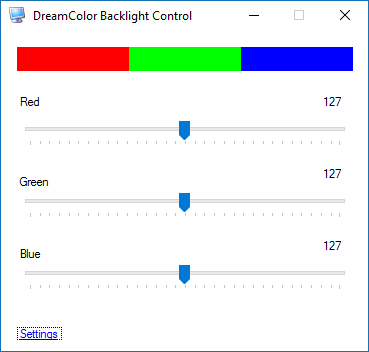
Channel control software
Finalizing the build
The Arduino fit nicely into an empty space nearly the cooling fan, although the USB plug was a bit as well long. I held it in identify with tape.
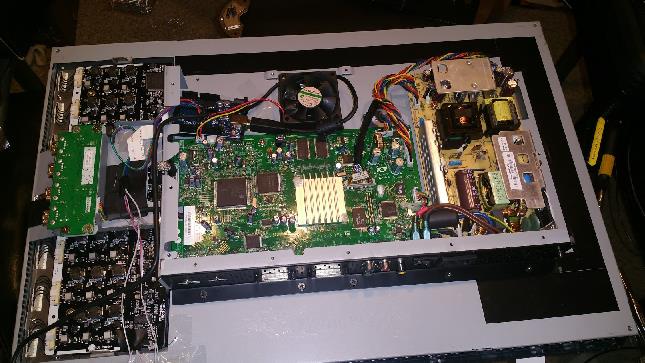
Arduino install
I ran the USB cable through a small hole I made in the outer casing of the monitor and plugged information technology into the hub on the side. This provides the Arduino with power and allows the computer to communicate with the Arduino through the uplink port.
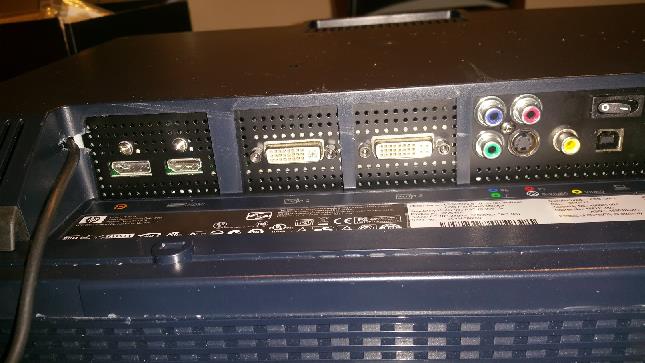
USB cable routed through the bottom
Limitations
Monitor controls
Since the color chip has been bypassed, the monitor'south brightness and white balance controls are no longer functional. The but style to accommodate brightness is through the app. The 3D LUT and matrix multiplier are withal functional, however, so it should exist possible to calibrate the monitor in hardware and employ the color profiles. I'm not certain if the official HP Advanced Profiling Solution volition nevertheless work as I exercise non ain i.
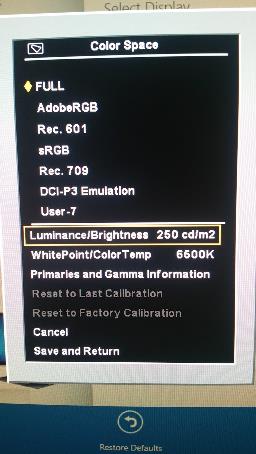
PWM frequency
The Arduino is unable to output a high enough PWM frequency. Thus, the backlight flickers very noticeably unless it'southward near maximum. Near the lower end of the range, it looks like a strobe low-cal. This is the biggest downside of my solution at this point; perhaps I tin observe a better microcontroller with a higher PWM frequency.
USB cable
Since the Arduino is powered via USB, and the backlight is now entirely dependent on the Arduino'southward PWM signal, the USB cable must be continued at all times. This uses upward i of the four USB ports on the monitor.
Conclusion
Here is a demonstration of the concluding product.
If you'd like to endeavour the mod yourself or await at my code, you may download it here.
I welcome any suggestions for comeback.
How To Fix Hp W2371b Purple/pink Tint,
Source: https://nookkin.com/articles/diy/fixing-a-purple-backlight-on-an-hp-dreamcolor.ndoc
Posted by: coatsallyne.blogspot.com


0 Response to "How To Fix Hp W2371b Purple/pink Tint"
Post a Comment